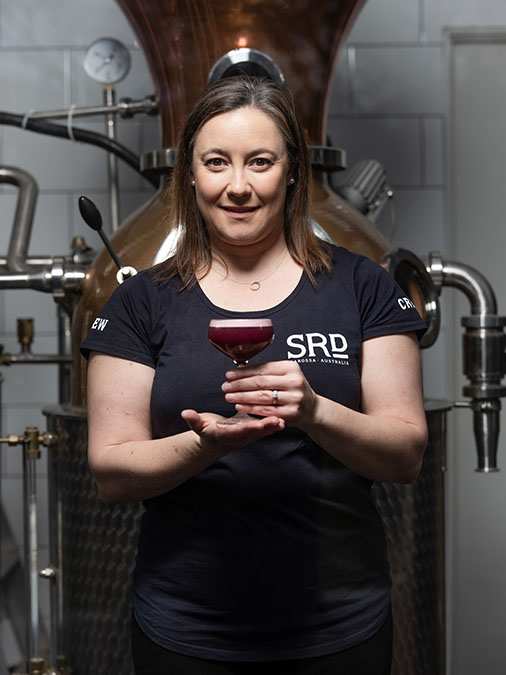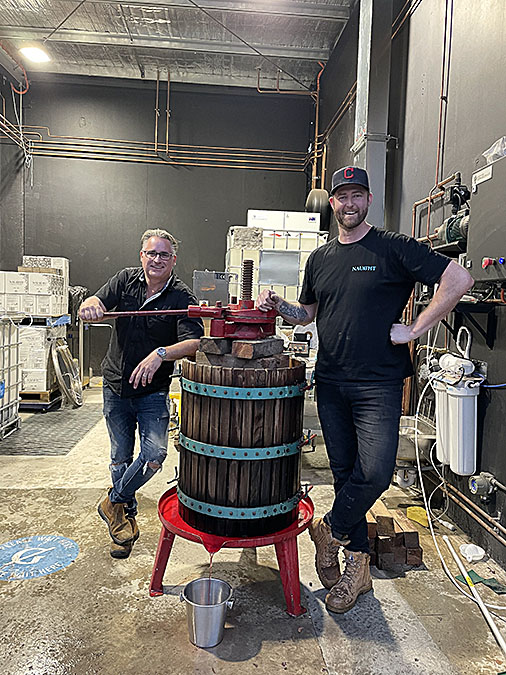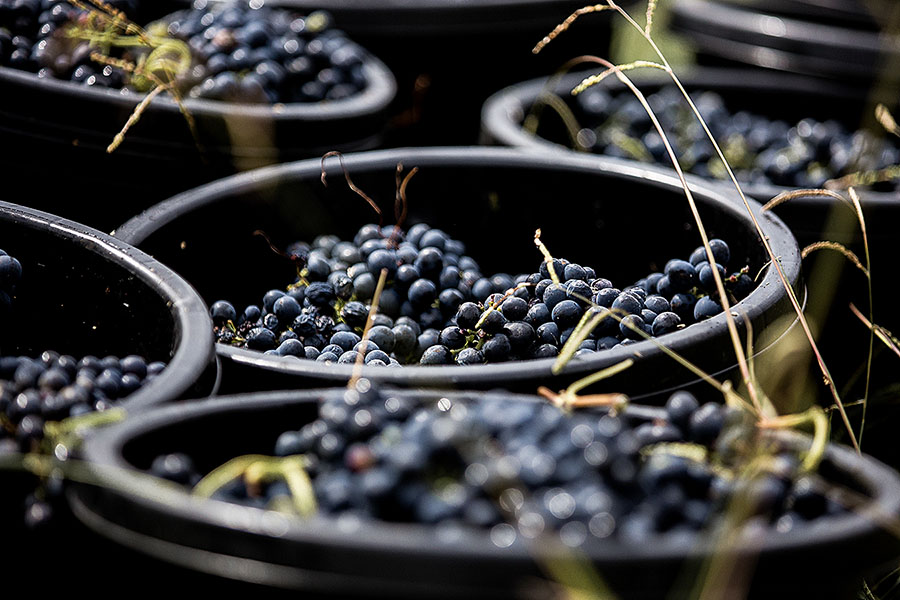In 2015, Four Pillars launched its Bloody Shiraz gin, which is made by steeping its Rare Dry Gin in shiraz grapes from the Yarra Valley, resulting in a sweet, vibrant, yet still “ginny” spirit. Since then, the grape-based gin category has grown significantly, with over 35 wine-inspired gins using grapes as a botanical, not just a base for distillation, now available in Australia.
With Australian grape gins winning global awards, distillers have whet gin drinkers’ appetites for these styles. While playing around with wine and gin is not new, what Australian distillers are doing is truly creating a new gin category. It can only be a matter of time before other wine-producing nations follow in our footsteps.
Grape, Meet Juniper
Using wine in gin is not a new phenomenon. Ferdinand’s Saar Dry gin, for instance, is infused with riesling grapes from the Saar region in Germany. French gin G’vine is made from grape-based spirit and infused with vine blossoms. There are also many Australian distillers that use grape spirit as the base of their gins or produce gin/wine hybrids where finished wine is simply added to gin.
But another kind of Australian grape gin is inspired by traditional English sloe gins. With traditional sloe gin, the berries of the blackthorn bush, which are native to the British Isles, are steeped in gin for months at a time. Then sugar is added to counteract the tart, tannic flavors of the sloe. The result is more of a liqueur than a gin; the most common ABV hovers around the 25% mark, although there are higher proof versions available.

Blackthorn bushes are not native to Australia; there are only a few small pockets in Tasmania that were planted by settlers. But there are lots of vineyards, so it seems obvious that distillers would turn to grapes to create a twist on sloe gin. And what started as an homage to the gins of old has now become a collaborative art between vigneron and distiller.
Cameron Mackenzie, distiller at Four Pillars, admits that at the beginning of their journey, the team did consider making sloe gin: “We knew that it was popular, as we were being asked when we were going to release one.”
Not one to disappoint people, he invested a huge amount of time to research the category. “We bought every single sloe gin on the market, tasted them and tested the sugar quantity,” he says. They were surprised by what they found: “The volume of sugar to spirit was shocking. Even the driest had an extraordinary amount.”
Somewhat fortuitously, it was around this time that a small parcel of grapes was dropped off by local producer Rob Dolin Wines. Mackenzie added them to a batch of Four Pillars Rare Dry gin and promptly forgot about it.
This “happy accident” had a profound impact on the business as well as the Australian gin category. The first bottling of Bloody Shiraz Gin sold out immediately. The popularity of the gin has not diminished, and the release of the latest vintage is a highlight of the year for gin lovers.
From that 250 kg in year one, Four Pillars now acquires around 100 tonnes of fruit per year, the majority of which comes from the Yarra Valley. The grapes are steeped in high-proof gin for eight weeks, then strained and bottled. Natural sugars from the grapes mean no additional sugar is required.
Production has been refined and developed over the years, evolving from tossing a few grapes in with some gin to a painstaking process where grapes are assessed and sourced by Cam and Behn Payten (one-half of low-intervention winemakers Payten & Jones) on an ongoing basis. “We now pick the grapes according to the characteristics we need,” Mackenzie explains. “Some grapes are picked early for a bit of acidity, while we pick some later for a bigger amount of sweetness and color. Any kink in vintages is ironed out by sourcing grapes from different vineyards, although they are always local to the distillery.”
Fresh Riffs on a New Category
Never Never Distilling Co. is based in McLaren Vale, South Australia, a region well-known for its grenache. Inspired by that local ingredient, head distiller Tim Boast set out to create a light, approachable grape gin that would “look good and work well in cocktails.”

The 2020 release of Never Never Distilling Co.’s Grenache gin — better known as “Ginache” gin — was made using one tonne of grapes from Chalk Hill Winery. The team there was making rosé, which suited Boast’s desire to produce a fresher, lighter wine gin with little tannin.
The grapes were steeped in Never Never’s signature Triple Juniper gin for 28 days and turned daily. Ginache has proved so successful that the brand has added new growers and recruited winemaker Jess Hodge to the production team. Boast is thrilled by the response to Ginache: “It was our fastest-selling new release and has been well received, not just by gin consumers, but by our local winemakers too.”
Nicole and Jon Durdin were living in the U.K. at the beginning of the gin renaissance, when Sipsmith gin had just launched in London. On their return to Australia, the husband-and-wife team set up Seppeltsfield Road Distillers in the heart of the Barossa.
For Nicole, it was a no-brainer to produce a grape gin. “We always talked about the potential of using shiraz grapes instead of sloe berries,” she says. “It would have been remiss of us not to use grapes from the Western Ridge of the Barossa, famous for its shiraz.”

Photo © Pete Thornton ™whatpeteshot
The team have been sourcing grapes from the same vineyard — only 1.5 km from their door — since their first release in 2018.
Chris Cameron, owner and distiller at Naught Distillery in Melbourne, launched his Australian Dry Naught Gin last year and released a Sangiovese Gin shortly afterwards. “It might seem quick to add another gin to the range, but I was working on this project at the same time as my R&D phase for Naught Gin,” explains Cameron. “I love sangiovese, so I did a practice run with 15 kg of sangiovese grapes from Ararat. I steeped them for two months in 42% ABV gin and the result was more than palatable, so I knew it was viable.”

With a larger quantity of grapes, Cameron tweaked his original production method and didn’t fully crush the grapes, allowing him to keep their color and flavor. The grapes were steeped in bottle-strength gin for two months before being pressed in an olive press, a gentle process to retain the sweeter, more delicate sangiovese flavors without extracting tannins.
Four Pillars has recently taken its shiraz gin series to a new level by releasing a single estate limited edition. James Halliday’s 2017 Winemaker of the Year 2017, Sarah Crowe of Yarra Yering, sold them two parcels of Underhill Shiraz from the 2021 vintage. Cam Mackenzie added the bunches of grapes to Rare Dry Gin that had spent around 14 months in old Yarra Yering Dry Red #1 and Dry Red #2 barrels that Crowe had given him in early 2020.
Bloody Underhill Shiraz Gin is the first release of what will become an annual Bloody Shiraz Single Vineyard Series. Where Four Pillars goes, others follow, so expect to see more single vineyard gins.
The original grape gins like Four Pillars Bloody Shiraz were initially consumed over ice. As the category has developed, brands have created signature serves around these gins and highlighted their versatility as a cocktail staple and even in a gin and tonic. Fever-Tree Australia’s Lemon Tonic is an unlikely but spectacular pairing with grape gins that brands and consumers have taken on board with relish.
The beauty of these gins is that consumers can comfortably select bottlings based on their wine preference, and by knowing the wine region, they will have a clearer idea of the flavor profile before purchasing. This is an exciting new category that presents opportunities for gin producers in other wine growing countries. Californian distillers could try cabernet sauvignon grapes, while French gin makers could experiment with the wildly popular pinot gris. The possibilities are endless.









